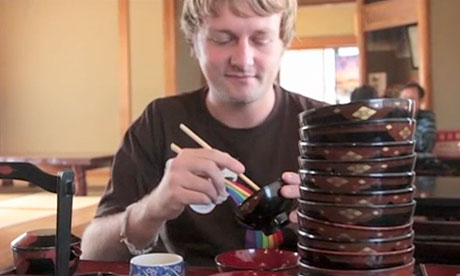
Few countries are as passionate and proud of their food as Japan. Each of its 47 prefectures is fiercely tribalistic about one dish or another, and noodles are particularly contentious. In Shikoku they argue about who produces the best udon (fat, chewy wheat-flour noodles), while on Kyushu ramen (slobbery Chinese-style wheat noodles) is the most popular. When it comes to soba (slippery, often cold, buckwheat noodles) almost every prefecture in northern Honshu claims to be its authoritative home.
As an uninitiated gaijin (foreigner), it's impossible for me to say which is the best, but this much I know: eating soba is never more fun than in Iwate – specifically, when ordering the unfortunately named wanko soba.
There are several theories about the origins of wanko soba, but one of the most likely is that a gluttonous feudal lord dropped in unexpectedly on some local peasants. Without much in the pantry, they sheepishly offered cold, plain soba noodles, fully expecting the lord to fly into a rage. But he loved them, asking for more and more and piling up small bowls as he wolfed the food down.
Today, that greedy spirit is alive and well: the aim of wanko soba is to eat as many small bowls of soba as possible – and you don't need to be a visiting lord to do it. It's very particular to Iwate (wanko means bowl in the local dialect), but even within the prefecture there are regional differences. Those wishing to give it a go in the capital, Morioka, have a waiter standing over them, serving more and more noodles until they submit.
But it was further south, in the historic town of Hiraizumi that I gave the dish a try. At Bashokan, 12 bowls are served at a time – you can order up to 24 for ¥1850 (£16) and take a dozen extra free on top of those. For cold noodles, it's not cheap. The noodles are plain but they are served with dashi sauce for dipping, wasabi to liven things up a bit, and dried seaweed to push to one side. All of this is supposed to make the endless repetition a little easier on the palate.
When I gingerly left the table, I could feel several miles of noodles wiggling and jiggling inside me. I tried to console myself with the knowledge that the Japanese regard soba as the healthiest of all their noodles, though forcing down 36 bowls probably took them well out of that bracket. My total was pitiful: depending on who you listen to, the record stands between 250 and 500 bowls. Perhaps, if it hadn't cost so much, I'd have managed a few more bowls, but I was never in danger of reaching three figures.
A few weeks later, hundreds of miles south in Kumamoto prefecture, I tried making soba. It was much more physically demanding than I'd expected: the process is still done by hand and the noodles have to be cut individually. With beads of sweat dripping off my nose and into the mixture, I began to understand why soba is not only considered the healthiest choice of noodle in Japan, but also why the manual labour drives the cost up. My final product was highly irregular in shape, but the taste, thankfully, was just about the same. I'm almost certain of that.
• Jamie Lafferty is a travel writer who ordinarily blogs at idoneaholiday.blogspot.com and tweets at @megaheid. He travelled to Japan as part of the Travel Volunteer Project.
For more information go to the Japan National Tourism Organisation's website: jnto.go.jp/eng

